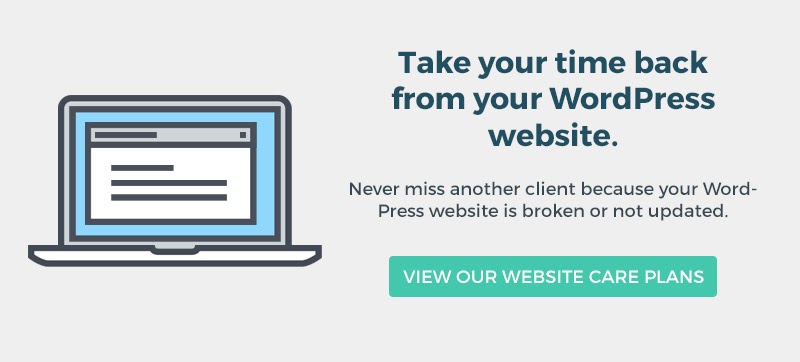In this week’s episode, we’re discussing things you can and should do AFTER you launch your therapy website.
Oftentimes, therapists consider the launch of their private practice website as the finish line.
Yes, it may have been a long road and big project for you to get your business online.
I do want you to celebrate your accomplishment, but also recognize that this is now a new season for marketing your private practice.
So let’s talk about what you can do to make sure you get the most traction out of your new website and use it as a marketing asset well into the future of your business.
This Episode Is Brought To You By

Prefer to read instead of listen to this week’s podcast episode? Read on below to learn about 8 things you should do after launching your private practice website.
1: Celebrate Your Victory
Launching a website is a BIG deal.
Having a website for your business can mean the difference between business growth and business failure.
You’ve just made a huge investment of time and or money in the growth of your business.
If done right, this website can fuel your business and help increase your income.
That’s huge!
Celebrate it. Go out for dinner at your favorite restaurant. Buy a bottle of your favorite wine or for me it’s Bellemeade Bourbon.
Your not only celebrating the completion of a big project but a new season for your business.
2: Update your Online Listings and Social Profiles With the Link to Your Therapy Website
If this website is new for you and your domain is newly established, you need to start telling the world where they can find you.
Take your domain and put it everywhere you can possibly think of. Everywhere!
This includes business directories your private practice may appear on.
You want to update your social media profiles as well. Even if you don’t use them for business, you want anyone and everyone to be able to find your website.
Having links from other websites is also a good SEO strategy.
They help Google see your business as an established one and directories with links to your website can help Google understand your physical location and boost your local SEO.
Learn more:
- 17: SEO For Therapists: How Backlinks Work & How To Use Them To Boost Your Google Rank
- 18. What is Local SEO and how Can You Use it in Your Private Practice?
3: Submit Your Sitemap to Google Search Console
A well-organized sitemap makes it easier for search engines to understand your site structure and content.
And you want to make sure that Google has crawled the latest and greatest version of your sitemap. Or for new websites, you just want to make sure Google sees it right away so it can start ranking it.
Google Search Console is a free service offered by Google that helps you monitor, maintain, and troubleshoot your site’s presence in Google Search results.
You don’t have to sign up for Search Console to be included in Google Search results, but Search Console helps you understand and improve how Google sees your site.
So sign up for this free service and once your website is connected, you’ll want to add your sitemap.
I’ll include a link in the shownotes for step by step instructions written by the makers of the Yoast SEO WordPress plugin.
4: Track Your Website Traffic
With online marketing, I’ve often heard it said that you can’t grow what you don’t measure.
No matter what your business goals are, keeping track of certain metrics, not only pertaining to your website but your entire business is paramount to moving your practice toward reaching those goals.
You’ll never be able to set and hit a goal unless you actually measure the results of your actions.
So get set up with Google Analytics and install it on your website.
You may not even use the data for a while, but it’s a free way to build a history of data so that you can understand how visitors are using your website, where they’re coming from and what pages get the most traffic.
All information that may be vital as you begin hiring professionals to do things like SEO or Google or Facebook ads.
5: Be Patient
This may be the hardest thing to do, especially when you’re in need of new clients.
You may have heard me say, “If you just build it, no one just come.”
And even if you’ve done or are actively doing search engine optimization on your new website, it can actually take three to six months for Google to even begin ranking your pages.
Getting traffic to your website takes time and if you’re not patient with the process, you’ll get frustrated and probably end up spinning your wheels trying a number of different strategies to make it happen.
I advise you to choose just a couple of marketing strategies, such as blogging or being active on social media to increase traffic to your new website.
But at that six-month mark, you’ll want to take a step back and evaluate your efforts, what’s working, what feels good to you, and what to focus on for the biggest impact.
When I launched Create My Therapist Website as a blog back in 2016, it took well over a year for me to see significant traffic from Google.
While I waited for Google to catch up, I implemented a blogging and Pinterest strategy to get traffic to the website, which is now paying off because both send that website traffic each month.
The key is to be consistent, track your metrics, and keep moving forward.
6: Get an SSL Certificate
Making sure that your website is secure is one of the easiest ways to improve your Google ranking for your website.
Now, just adding an SSL certificate to your website doesn’t necessarily mean you’ll be number one in search results but, it Google does consider security a very important factor when ranking your website.
Usually, your website host can help you get this set up for a yearly cost.
Reach out to them and just get that little padlock on your website to let your visitors and Google know your site is secure.
7: Back Up Your Therapy Website Regularly
This applies to anyone using WordPress or a self-hosted HTML website.
I can’t stress how important it is to ensure that your website is backed up regularly.
With every website we launch here at Private Practice Elevation, we encourage our clients to either learn how to maintain that website themselves or join one of our WordPress care plans.
But, unfortunately, some will neglect this important safeguard for their website.
If the software is maintained and updated, problems can arise and it can become difficult to diagnose, leaving you with a broken website that your clients can use.
This means lost clients and lost revenue to your private practice.
Having a daily backup of your website means that you’ll be able to restore your website to a working version and keep attracting clients to your business.
So either learn how to set up automatic backups, consult with your hosting company or hire someone to take care of your maintenance to make sure your website is protected.
For more on the importance of therapy website maintenance, check out this article:
Why Website Maintenance is Key to a Successful Therapy Website
8: Take Care of Your Security
This goes along with the maintenance mentioned in point number 7.
Backups can help you when something DOES go wrong on your WordPress website.
But taking care of security upfront can help you AVOID something going wrong.
A few things you can do to make sure your website is secure as possible:
- Keep your WordPress files, plugin files and theme up to date
- Make sure your username is not the default “admin”
- Use very strong passwords
- Use a security plugin to limit the number of times someone can attempt to log in to your website
For more on some how-tos when it comes to your WordPress website security, check out this article: The Best Ways To Secure Your Private Practice Website
Conclusion
Launching a new website for your private practice means a whole new season of growth and marketing for your business has begun.
Making sure to do some or all of the steps above can help you get the most traction out of your new investment and kickstart your growth.
I encourage you to choose a few of these steps and put them in place to keep your marketing moving forward.
Subscribe & Review in iTunes
If you’re not yet subscribed to the podcast I want to encourage you to do that today. This is the best way to make sure you don’t miss an episode! Click here to subscribe on iTunes.
And if you’re feeling extra generous, I’d love to hear what you think about the podcast. Reviews help others find the podcast plus I’d really love to hear what you think! Click here to leave a review. Just click on “Ratings & Reviews” then “Write a review.” Let me know what you like best about the podcast. Thank you!
Links mentioned in this episode:
- 17: SEO For Therapists: How Backlinks Work & How To Use Them To Boost Your Google Rank
- 18. What is Local SEO and how Can You Use it in Your Private Practice?
- Yoast SEO: How to Submit Your Sitemap To Search Engines
- 01. What Metrics Should I Be Tracking On My Private Practice Website?
- Why Website Maintenance is Key to a Successful Therapy Website
- The Best Ways To Secure Your Private Practice Website


